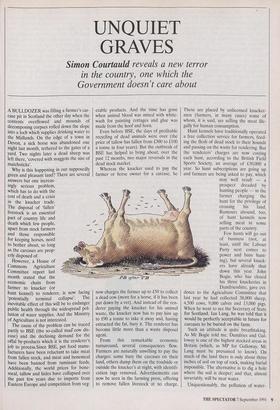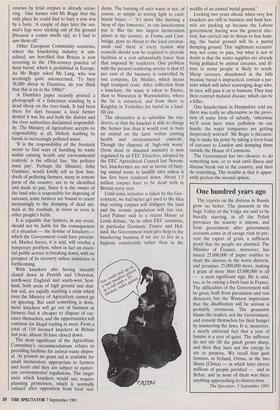UNQUIET GRAVES
Simon Courtauld reveals a new terror in the country, one which the Government doesn't care about
A BULLDOZER was filling a farmer's car- case pit in Scotland the other day when the contents overflowed and mounds of decomposing corpses rolled down the slope Into a loch which supplies drinking water to the Midlands. On the edge of a town in Devon, a sick horse was abandoned one night last month, tethered to the gates of a yard. Two nights later a dead sheep was left there, 'covered with maggots the size of matchsticks'.
n our supposedly here are several Why is this happening i green and pleasant land? T answers but one increas- ingly serious problem, which has to do with the cost of death and a crisis in the knacker trade. The disposal of 'fallen' livestock is an essential part of country life and death which few people, apart from stock farmers and those responsible for keeping horses, need to bother about, so long as the carcases are prop- erly disposed of.
However, a House of Commons Agriculture Committee report last month stated that the economic chain from farmer to knacker (or hunt kennel) to renderer, is now facing 'potentially terminal collapse'. The inevitable effect of this will be to endanger public health through the widespread pol- lution of water supplies. And the Ministry of Agriculture is not interested. The cause of the problem can be traced partly to BSE (the so-called mad cow dis- ease) and the declining demand for the offal by-products which it is the renderer's job to process.Since BSE, pet food manu- facturers have been reluctant to take meat from fallen stock, and meat and bonemeal have been banned from ruminant feeds. Additionally, the world prices for bone- meal, tallow and hides have collapsed over the past few years due to imports from Eastern Europe and competition from veg- etable products. And the time has gone when animal blood was mixed with white- wash for painting cottages and glue was made from the hoof and horn.
Even before BSE, the days of profitable recycling of dead animals were over (the price of tallow has fallen from £300 to £100 a tonne in four years). But the outbreak of BSE has helped to bring about, over the past 12 months, two major reversals in the dead stock market.
Whereas the knacker used to pay the farmer or horse owner for a carcase, he
now charges the farmer up to £50 to collect a dead cow (more for a horse, if it has been put down by a vet). And instead of the ren- derer paying the knacker for his animal waste, the knacker now has to pay him up to £90 a tonne to take it away and, having extracted the fat, bury it. The renderer has become little more than a waste disposal agent.
From this remarkable economic turnaround, several consequences flow. Farmers are naturally unwilling to pay the charges: some bury the carcases on their land, others dump them on the toadside or outside the knacker's at night, with identifi- cation tags removed. Advertisements can now be seen in the farming press, offering to remove fallen livestock at no charge. These are placed by unlicensed knacker- men (farmers, in many cases) some of whom, it is said, are selling the meat ille- gally for human consumption.
Hunt kennels have traditionally operated a free collection service for farmers, feed- ing the flesh of dead stock to their hounds and passing on the waste for rendering. But the renderers' charges are now costing each hunt, according to the British Field Sports Society, an average of £30,000 a year. So hunt subscriptions are going up and farmers are being asked to pay, which may well result — a prospect dreaded by hunting people — in the farmer charging the hunt for the privilege of crossing his land. Rumours abound, too, of hunt kennels now selling meat in some parts of the country.
Such an attitude is quite breathtaking. As Mr Bogie told me, Dumfries and Gal- loway is one of the highest stocked areas in Britain (which, as MP for Galloway, Mr Lang must be presumed to know). On much of the land there is only about three inches of soil on top of rock, making burial impossible. The alternative is to dig a hole where the soil is deeper; and that, almost invariably, will be near water.
Unquestionably, the pollution of water- courses by fetid corpses is already occur- ring. One farmer told Mr Bogie that the only place he could find to bury a cow was by a burn. 'A couple of days later the ani- mal's legs were sticking out of the ground [because a corpse swells up], so I had to saw them off.'
Other European Community countries, where the knackering industry is sub- sidised, are horrified that Britain is now reverting to the 19th-century practice of farm burial, which is prohibited in Europe. As Mr Bogie asked Mr Lang, who was seemingly quite unconcerned, To bury 38,000 sheep in Dumfries, do you think that this is on in the 1990s?'
A Dumfries paper recently printed a photograph of a fisherman standing by a dead sheep on the river-bank. It had been there for days because a local farmer denied it was his and both the district and the river authorities disclaimed responsibil- ity. The Ministry of Agriculture accepts no responsibility at all, blithely washing its hands in increasingly polluted water.
'It is the responsibility of the livestock sector to find ways of handling its waste within existing health and environmental controls' is the official line: 'the polluter must pay'. Perhaps the Minister, John Gummer, would kindly tell us how hun- dreds of polluting farmers, many in remote parts of the country, are to be identified and made to pay. Since it is the owner of the land who is responsible for disposing of carcases, some farmers are bound to resort increasingly to the dumping of dead ani- mals at the roadside, in rivers or even in other people's fields.
It is arguable that farmers, in any event, should not be liable for the consequences of a situation — the demise of knackers — which the Government could have prevent- ed. Market forces, it is said, will resolve a temporary problem, when in fact an essen- tial public service is breaking down, with no prospect of its recovery unless assistance is forthcoming.
With knackers also having recently closed down in Penrith and Ulverston, north-west England and south-west Scot- land, both areas of high ground and shal- low soil, are rapidly reaching a crisis which even the Ministry of Agriculture cannot go on ignoring. But until something is done, more knackers will go out of business as farmers find it cheaper to dispose of car- cases themselves, and the opportunities will continue for illegal trading in meat. From a total of 110 licensed knackers in Britain last year, almost 30 have closed down.
The most significant of the Agriculture Committee's recommendations relates to providing facilities for animal waste dispos- al. At present no grant aid is available for small incinerators appropriate to farmers and hunts and they are subject to numer- ous environmental regulations. The larger units which knackers would use require planning permission, which is normally refused after opposition from local resi- dents. The burning of such waste is not, of course, as simple as setting light to card- board boxes — 'it's more like burning a heap of ripe tomatoes,' as one knackerman put it. But the two largest incineration plants in the country, at Frome and Cam- bridge, pose no threat to the local environ- ment and there is every reason why councils should now be required to provide facilities at a cost substantially lower than that imposed by renderers. One problem with the present rendering service is that 65 per cent of the business is controlled by one company, De Mulder, which incurs high transport costs. After collection from a knackery, the waste is taken to Exeter, then to Nuneaton in Warwickshire, where the fat is extracted, and from there to Keighley in Yorkshire for burial in a land- fill site.
The alternative is to subsidise the ren- derers, so that the knacker is able to charge the farmer less than it would cost to bury an animal on the farm 'within existing health and environmental controls'. Though the disposal of 'high-risk waste' (from dead or diseased animals) is .now regulated by an EEC Directive, adopted by the EEC Agricultural Council last Novem- ber, knackermen are not in favour of bury- ing animal waste in landfill sites unless it has first been rendered down. About 1.5 million corpses have to be dealt with in Britain every year.
Until some initiative is taken by the Gov- ernment, we had better get used to the idea that rotting corpses will disfigure the land and the vermin population will run riot. Lord Palmer said in a recent House of Lords debate, 'As in other EEC countries, in particular Germany, France and Hol- land, the Government must give help to the knackering business if we are to live in a hygienic countryside rather than in the middle of an animal burial ground.'
Looking two years ahead, when very few knackers are still in business and hunt ken- nels are packing up because the Labour government, having won the general elec- tion, has carried out its threat to ban hunt- ing, the burial ground will be a putrid dumping ground. This 'nightmare scenario' may not come to pass, but what is not in doubt is that the water supplies are already being polluted by animal carcases, and ill- ness to many people is likely to result. Sheep carcases, abandoned in the hills because burial is impractical, contain a par- asite which will infect scavenging dogs who, in turn, will pass it on to humans. They may then contract hydatid disease, which can be a killer.
One knackerman in Hampshire told me there was really no alternative to the provi- sion of some form of subsidy, 'otherwise we'll soon have mass pollution on our hands; the water companies are getting desperately worried'. Mr Bogie is threaten- ing to make his point by taking a lorry-load of carcases to London and dumping them outside the House of Commons.
The Government has two choices: to do something now, or to wait until illness and disease break out in the country, and then do something. The trouble is that it appar- ently prefers the second option.



















































 Previous page
Previous page